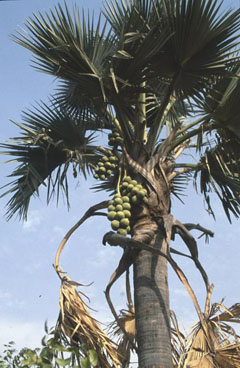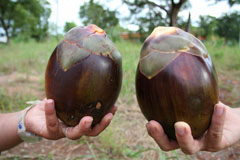 |
|
palmweb.org |
 |
| wikimedia.org User:Marco_Schmidt |
Translate this page:
Summary
Borassus akeassii or African Fan Palm is an evergreen, single-stemmed palm up to 15 m high and 40 to 50 cm in diameter. The roots of this species are used as a mouthwash and as treatment for stomach parasites, asthma, and sore throat. The plant produces a sap that is fermented into wine. The fruit is eaten fresh or dried. Young seedlings and the terminal bud of the palm are consumed as vegetable. The leaves have various uses and the wood produces high quality timber that is resistant to termites and fungi.
Other Names: Ake Assi's, Palmyra Palm
Physical Characteristics

 Borassus akeassii is an evergreen Tree growing to 10 m (32ft) by 5 m (16ft) at a slow rate.
Borassus akeassii is an evergreen Tree growing to 10 m (32ft) by 5 m (16ft) at a slow rate.
See above for USDA hardiness. It is hardy to UK zone 10. The flowers are pollinated by Insects.
It is noted for attracting wildlife.
Suitable for: light (sandy), medium (loamy) and heavy (clay) soils, prefers well-drained soil and can grow in nutritionally poor soil. Suitable pH: mildly acid, neutral and basic (mildly alkaline) soils and can grow in very acid and very alkaline soils.
It cannot grow in the shade. It prefers dry or moist soil and can tolerate drought.
UK Hardiness Map
US Hardiness Map
Synonyms
Borassus aethiopum domesticus A.Chev.
Plant Habitats
Edible Uses
Edible Parts: Fruit Sap Shoots
Edible Uses: Drink
The apical bud is hollowed out and the resulting sap is collected and fermented. The wine is made for sale enhancing local earnings), to drink at traditional ceremonies, as well as forming a part of the balanced diet in many rural areas, and used for aphrodisiac preparations[ 325 ]. Excessive tapping of the sap kills the plant[ 325 ]. Fruit - fresh or dried[ 335 ]. Eaten as a food supplement[ 325 ]. The fruit is 15cm in diameter and is produced in large clusters[ 335 ]. The endosperm of immature seeds - raw[ 335 ]. Young seedlings - eaten as a vegetable like asparagus[ 317 ]. The terminal bud of the palm is used as palm cabbage[ 317 ]. Eating this bud leads to the eventual death of the plant since it is unable to produce side shoots[ K ].
References More on Edible Uses
Medicinal Uses
Plants For A Future can not take any responsibility for any adverse effects from the use of plants. Always seek advice from a professional before using a plant medicinally.
Anthelmintic Antiasthmatic Aphrodisiac Mouthwash
The roots serve for the treatment of stomach parasites, sore throats and asthma, as well as being used for a mouthwash[ 325 ]
References More on Medicinal Uses
The Bookshop: Edible Plant Books
Our Latest books on Perennial Plants For Food Forests and Permaculture Gardens in paperback or digital formats.

Edible Tropical Plants
Food Forest Plants for Hotter Conditions: 250+ Plants For Tropical Food Forests & Permaculture Gardens.
More

Edible Temperate Plants
Plants for Your Food Forest: 500 Plants for Temperate Food Forests & Permaculture Gardens.
More

More Books
PFAF have eight books available in paperback and digital formats. Browse the shop for more information.
Shop Now
Other Uses
Wood
Other uses rating: Medium (3/5). Other Uses The leaves are used for various purposes including for shelter[ 314 ]. The dark brown, coarsely fibrous wood is a highly prized timber locally[ 325 ]. It is very resistant to termites and fungi, and is used in carpentry, construction and also for household articles[ 325 ].
Special Uses
Food Forest
References More on Other Uses
Cultivation details
It is found in areas with a mean annual rainfall in the range 800 - 1,100mm[ 325 ]. Requires a sunny position and a well-drained soil[ 325 ]. Plants are able to extract nutrients, and thus grow, on very nutrient-poor soils[ 325 ]. Established plants are drought tolerant[ 314 ]. Established plants can resist fires[ 325 ]. A slow-growing but long lived tree to over 100 years old[ 325 ]. It does not start flowering until middle-aged[ 325 ]. A dioecious species, both male and female forms need to be grown if fruit and seed are required
References Carbon Farming Information and Carbon Sequestration Information
Temperature Converter
Type a value in the Celsius field to convert the value to Fahrenheit:
Fahrenheit:
The PFAF Bookshop
Plants For A Future have a number of books available in paperback and digital form. Book titles include Edible Plants, Edible Perennials, Edible Trees,Edible Shrubs, Woodland Gardening, and Temperate Food Forest Plants. Our new book is Food Forest Plants For Hotter Conditions (Tropical and Sub-Tropical).
Shop Now
Plant Propagation
Seed - it has a short viability and should be sown as soon as it is removed from the fruit pulp[ 325 ]. The seed does not require pre-treatment and germinated in about 4 weeks. The plant produces a very long taproot, which can be 1 metre long when top growth is only 1cm tall, and so it is best sown in situ[ 325 ].
Other Names
If available other names are mentioned here
Borassus akeassii or African Fan Palm. Other Names: Ake Assi's, Palmyra Palm
Native Range
AFRICA: Benin, Burkina, Central African Repu, Guinea-Bissau, Ivory Coast, Mali, Niger, Nigeria, Senegal, Zaïre.
Weed Potential
Right plant wrong place. We are currently updating this section.
Please note that a plant may be invasive in one area but may not in your area so it's worth checking.
None Known
Conservation Status
IUCN Red List of Threatened Plants Status : This taxon has not yet been assessed.

Growth: S = slow M = medium F = fast. Soil: L = light (sandy) M = medium H = heavy (clay). pH: A = acid N = neutral B = basic (alkaline). Shade: F = full shade S = semi-shade N = no shade. Moisture: D = dry M = Moist We = wet Wa = water.
Now available:
Food Forest Plants for Mediterranean Conditions
350+ Perennial Plants For Mediterranean and Drier Food Forests and Permaculture Gardens.
[Paperback and eBook]
This is the third in Plants For A Future's series of plant guides for food forests tailored to
specific climate zones. Following volumes on temperate and tropical ecosystems, this book focuses
on species suited to Mediterranean conditions—regions with hot, dry summers and cool, wet winters,
often facing the added challenge of climate change.
Read More
Expert comment
Author
Bayton, Ou?dr. & Guinko
Botanical References
Links / References
For a list of references used on this page please go here
A special thanks to Ken Fern for some of the information used on this page.
Readers comment
| Add a comment |
|
If you have important information about this plant that may help other users please add a comment or link below. Only comments or links that are felt to be directly relevant to a plant will be included. If you think a comment/link or information contained on this page is inaccurate or misleading we would welcome your feedback at [email protected]. If you have questions about a plant please use the Forum on this website as we do not have the resources to answer questions ourselves.
* Please note: the comments by website users are not necessarily those held by PFAF and may give misleading or inaccurate information.
To leave a comment please Register or login here All comments need to be approved so will not appear immediately.
|
Subject : Borassus akeassii
|
|
|
|